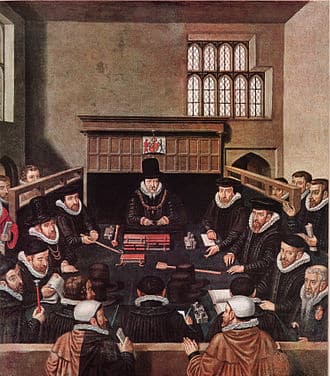
Wardships were an important feature in Tudor England. All lands and titles in England were the property of the crown. The sovereign could and would grant hereditary rights to them, but if an owner died with no legitimate heir, everything reverted to the crown. When an owner died leaving a minor heir, the king was responsible for his or her upbringing – and all the revenues of the estate (less the third allocated to the widow as dower until he turned 21 or she turned 14. There was a special Court of Wards and Liveries created to administer these rights and obligations – though the easier and more typical route was to sell or give these wardships to a courtier.
One well-known example of this is Katherine Willoughby, only daughter of the William Willoughby, the 11th Baron Willoughby de Eresby and his second wife, Maria de Salinas. William died when Katherine was only seven – and Henry sold her wardship to Charles Brandon. Now, the choice was actually a good one for Katherine, because Charles was married at the time to Mary Tudor and therefore offered a highly desirable household. Also, he was powerful enough to intervene in an ongoing dispute over the extent of the estate’s holdings. Charles’ plan had been to marry Katherine to his son when they both were of age – but then Mary died – which meant that his household no longer had a ranking female who would be able to properly chaperone an unmarried Katherine. Threatened with the loss of this really valuable wardship (son Henry was only ten, too young to wed), Charles quickly married the fourteen-year-old Katherine himself (he was forty-nine).
I just keep thinking about poor Maria de Salinas, and all the other poor mothers, who basically lost control of their children just because their husbands died. But at least Maria knew that her daughter was being taken care of – and that she had an ally in the process. Today’s letter, written by Catherine, Lady Blount in 1533, shows the shadow side of this practice, the issues facing a widow trying to keep everything together when the funds were not so ample and the support not so clear….
Right worshipful sir,
I recommend me unto you. I must beseech you to be good master unto me, as you have been at all times. Where it pleased you to take the pain to make an end betwixt master Kitson and me for four hundred marks, and after that it pleased the duke of Norfolk, because he had my son in ward, to indent with me that he would see Kitson paid at our Lady-day in Lent; and his grace said, that Kitson should be content to tarry until then; and so I bought my son of my lord, and must give him a hundred pound, to the intent that I would marry my son to his comfort. And so I have bargained with sir John Talbot for my son and have provided that the four hundred marks shall be forthcoming at our Lady-day, and the hundred pounds besides to my lord, and I have no penny of profit by the wardship of my son, but that that I have granted to was to save my land. And now my lord’s grace sendeth me word that Kitson will have his money at Candlemas, or else to enter into the land. And so I know not what to do in it, for I trusted upon such grants as were made to me. It is not much betwixt Candlemas and our Lady-day for him to forbear his money. Wherefore I must beseech you to be good master to me and to help me in it, as my trust is in you, as I and my son pray daily for you, which we are bound daily to do; as knoweth God, who send you good health.
Written at Knightly, the 20th day of January
***
If you like my posts, you’ll love my books! My Seymour Saga trilogy tells the gripping story of the short-lived dynasty that shaped the Tudor Era. Jane the Quene skews romantic, The Path to Somerset is pure Game of Thrones (without the dragons), and The Boy King is a noir coming-of-age. Get them now through Amazon, Barnes & Noble, Kobo, and Apple, or even your local independent bookstore!

(PS Already read them? Did you love them? Then please review them – even just a stars rating! It makes a huge difference in helping new readers find them and would mean the world to me!)

Be First to Comment